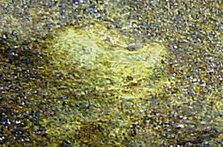
 | Jarosite on Mars |
On Earth Jarosite is rare and is mainly associated with the ultimate stage of pyrite oxidation in clay. On the other hand, Jarosite is quite abundant on Mars. It has been detected in the past by NASA's Spirit and Opportunity rovers and more recently by Curiosity. Jarosite was first spotted on Mars in 2004 by Opportunity and at that time this discovery made headlines. This was because Jarosite needs water, iron, sulfate, potassium and acidic conditions to form and these conditions are not easily achieved on Mars. Therefore, it is still unclear exactly how this mineral came to be so common on the Red Planet.
Jarosite is a hydrous sulfate of potassium (K) and ferric iron (F+3). Its chemical formula is KFe3(SO4)2(OH)6. Jarosite is formed in ore deposits by the oxidation of iron sulfides. (Pyrite is the most common sulfide mineral (FeS2), better known as fool's gold.) Jarosite can also be found in leftover waste in mines where acidic conditions are common.
Interestingly, recently Jarosite has also been found deep in ice cores extracted from Antarctica. In these cores, dust particles of Jarosite crystals were uncovered by Giovanni Baccolo and his colleagues from the University of Milano, within the layer of a 1620 meter-long core while the scientists were searching for minerals which could be used to study ice age cycles.
At a depth of around 1000 meters of the ice core, the Jarosite crystals were found adhering to residual silica-rich particles. To confirm the mineralís identity the researchers used x-rays to measure ray absorption. They also examined grains using an electron microscope. Their study (recently published in Nature Communications) showed that the crystals were cracked and lacked sharp edges - which one would expect following erosion within pockets of ice.
This surprising discovery may shed new light as to the formation of Jarosite on Mars. Most previous hypotheses have suggested that Jarosite was formed by the interaction of acidic fluids and weathered sediments in Martian basins which were sporadically filled by water. A limited amount of water is not only necessary for the formation of Jarosite, but is also critical for its long-term preservation. The new study suggests that Jarosite formation would occur during the weathering of mafic dust or fine-grained ash trapped in massive blocks of ice, similar to what was seen in the Antarctic ice core. The only problem with this most recent theory is the scale of things. As Megan Elwood Madden, a geochemist at the University of Oklahoma points out: "On Mars, this is not just some thin film,...These are meters-thick deposits."
Although Baccolo and his colleagues concede that their ice core contained a minute amount of Jarosite they argue that there is also much less dust and ash in Antarctica than there is on Mars. "Mars is such a dusty place - everything is covered in dust," Baccolo says. More ash would favor more Jarosite formation under the right conditions, he says.
Journal Reference:
| _______________________________ | ||||
| Home | | | Shopping | | | Database |
© Biscuit Software 2004-2019
All rights reserved